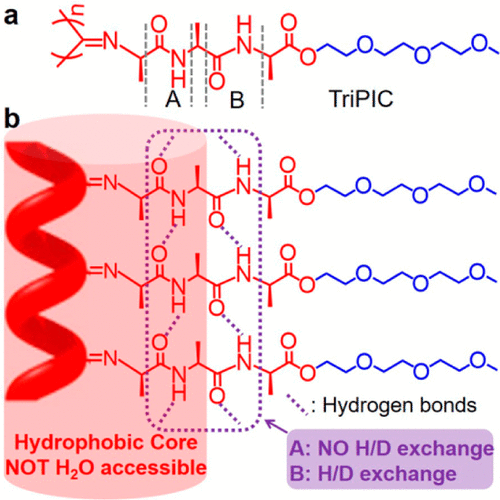当前位置:
X-MOL 学术
›
Macromolecules
›
论文详情
Our official English website, www.x-mol.net, welcomes your
feedback! (Note: you will need to create a separate account there.)
Strategies To Increase the Thermal Stability of Truly Biomimetic Hydrogels: Combining Hydrophobicity and Directed Hydrogen Bonding
Macromolecules ( IF 5.1 ) Pub Date : 2017-11-15 00:00:00 , DOI: 10.1021/acs.macromol.7b01832 Hongbo Yuan 1, 2 , Jialiang Xu 2, 3 , Eliane P. van Dam 4 , Giulia Giubertoni 4 , Yves L. A. Rezus 4 , Roel Hammink 2 , Huib J. Bakker 4 , Yong Zhan 1 , Alan E. Rowan 2, 5 , Chengfen Xing 1 , Paul H. J. Kouwer 2
Macromolecules ( IF 5.1 ) Pub Date : 2017-11-15 00:00:00 , DOI: 10.1021/acs.macromol.7b01832 Hongbo Yuan 1, 2 , Jialiang Xu 2, 3 , Eliane P. van Dam 4 , Giulia Giubertoni 4 , Yves L. A. Rezus 4 , Roel Hammink 2 , Huib J. Bakker 4 , Yong Zhan 1 , Alan E. Rowan 2, 5 , Chengfen Xing 1 , Paul H. J. Kouwer 2
Affiliation

|
Enhancing the thermal stability of proteins is an important task for protein engineering. There are several ways to increase the thermal stability of proteins in biology, such as greater hydrophobic interactions, increased helical content, decreased occurrence of thermolabile residues, or stable hydrogen bonds. Here, we describe a well-defined polymer based on β-helical polyisocyanotripeptides (TriPIC) that uses biological approaches, including hydrogen bonding and hydrophobic interactions for its exceptional thermal stability in aqueous solutions. The multiple hydrogen bonding arrays along the polymer backbone shield the hydrophobic core from water. Variable temperature CD and FTIR studies indicate that, on heating, a better packed polymer conformation further stiffens the backbone. Driven by hydrophobic interactions, TriPIC solutions give fully reversible hydrogels that can withstand high temperatures (80 °C) for extended times. Cryo-scanning electron microscopy (cryo-SEM), small-angle X-ray scattering (SAXS), and thorough rheological analysis show that the hydrogel has a bundled architecture, which gives rise to strain stiffening effects on deformation of the gel, analogous to many biological hydrogels.
中文翻译:

提高真正仿生水凝胶的热稳定性的策略:结合疏水性和直接氢键。
增强蛋白质的热稳定性是蛋白质工程的重要任务。有几种增加蛋白质在生物学中的热稳定性的方法,例如更大的疏水相互作用,增加的螺旋含量,减少热不稳定残基的出现或稳定的氢键。在这里,我们描述了一种基于β螺旋聚异氰基三肽(TriPIC)的明确定义的聚合物,该聚合物使用了生物方法,包括氢键和疏水相互作用,以使其在水溶液中具有出色的热稳定性。沿着聚合物主链的多个氢键阵列将疏水核与水隔离。可变温度CD和FTIR研究表明,加热后,更好填充的聚合物构象会进一步使骨架坚硬。在疏水相互作用的驱动下,TriPIC解决方案提供了完全可逆的水凝胶,可以长时间承受高温(80°C)。低温扫描电子显微镜(cryo-SEM),小角度X射线散射(SAXS)和彻底的流变分析表明,水凝胶具有束缚的结构,从而对凝胶的变形产生应变变硬作用,类似于许多生物水凝胶。
更新日期:2017-11-15
中文翻译:

提高真正仿生水凝胶的热稳定性的策略:结合疏水性和直接氢键。
增强蛋白质的热稳定性是蛋白质工程的重要任务。有几种增加蛋白质在生物学中的热稳定性的方法,例如更大的疏水相互作用,增加的螺旋含量,减少热不稳定残基的出现或稳定的氢键。在这里,我们描述了一种基于β螺旋聚异氰基三肽(TriPIC)的明确定义的聚合物,该聚合物使用了生物方法,包括氢键和疏水相互作用,以使其在水溶液中具有出色的热稳定性。沿着聚合物主链的多个氢键阵列将疏水核与水隔离。可变温度CD和FTIR研究表明,加热后,更好填充的聚合物构象会进一步使骨架坚硬。在疏水相互作用的驱动下,TriPIC解决方案提供了完全可逆的水凝胶,可以长时间承受高温(80°C)。低温扫描电子显微镜(cryo-SEM),小角度X射线散射(SAXS)和彻底的流变分析表明,水凝胶具有束缚的结构,从而对凝胶的变形产生应变变硬作用,类似于许多生物水凝胶。











































 京公网安备 11010802027423号
京公网安备 11010802027423号